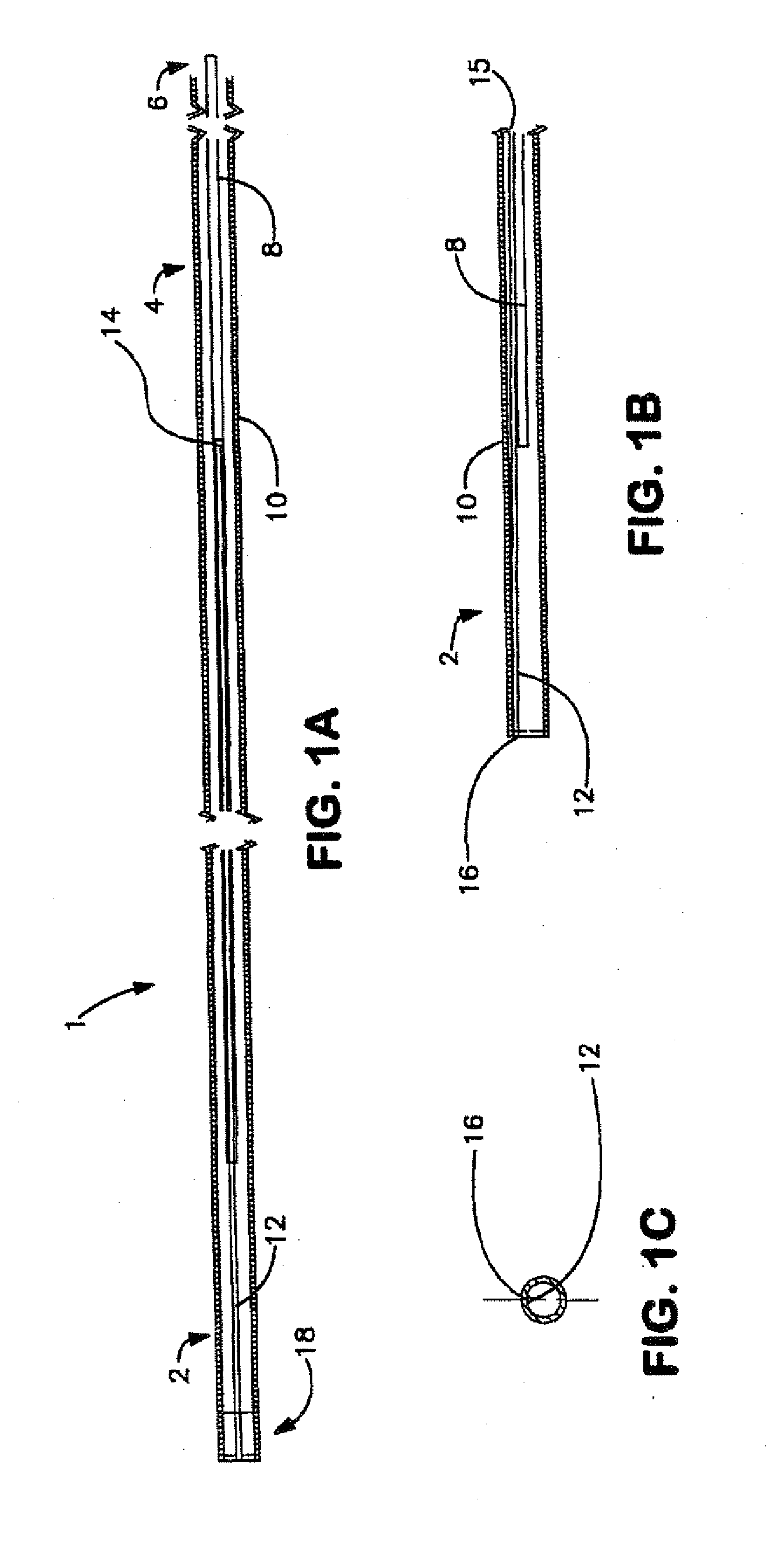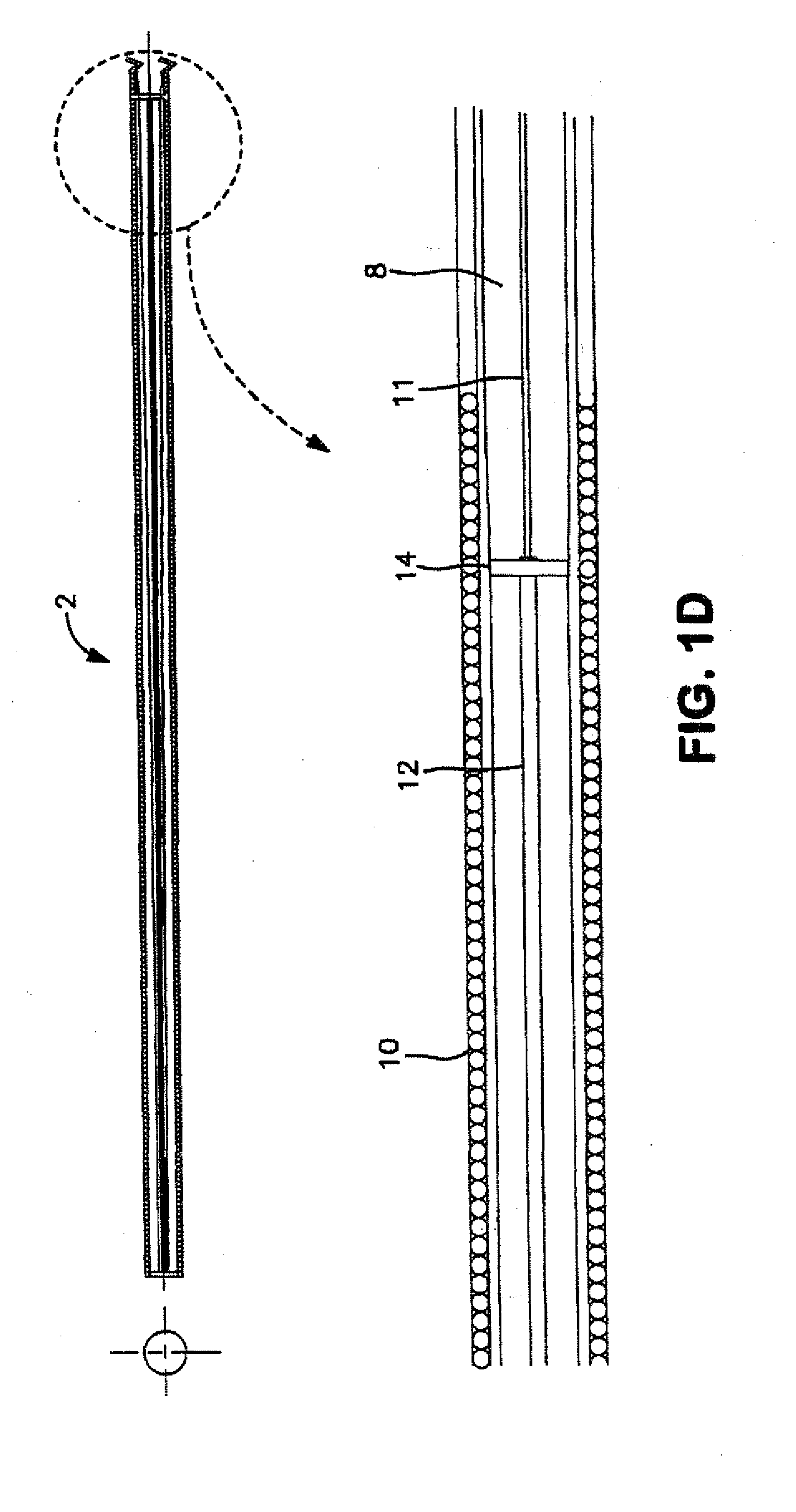[0014]The apparatus, methods and systems according to the present invention, in their various aspects, address any of a range of problems associated with the manipulation of catheters and guidewires within vascular systems during invasive diagnostic or interventional radiological procedures or in other fields requiring precisely controlled penetration of narrow passageways. Among other advantages, embodiments of the present invention provide controllers for variable control, steerable guidewires that may have one more of the following advantages: coaxial structure, over-the-wire
catheter compatibility, remote
controllability, variably deflectable tip, low profile guidewire,
controllability by a detachable, side-entry, easily positioned, single-handedly manipulated, combination torque and guidewire tip control device, ergonomic
controllability from a position adjacent to the
point of entry into the vasculature (or other passageway being accessed), and economical manufacturability. Aspects of the present invention also encompass or facilitate a reduction, or minimization, of the number of guidewire or guide-
catheter exchanges necessary to accomplish a designated task or procedure, yielding an
advantage not only in terms of the saving of time and other resources, but more importantly in reducing trauma to the passageways in which the guidewire is deployed. The combination of guidewire and controller according to aspects of the present invention allow convenient side-entry and single-handed repositioning of the controller along the length of the guidewire to allow the practitioner to manipulate the guidewire tip at any location along the guidewire, including at or near the
point of entry, thereby improving ergonomics, control, efficiency, and ultimately, for medical guidewires, patient safety.
[0015]When used in the field of interventional
radiology, the apparatus, systems and methods according to the present invention provide a solution in the form of an economical, completely coaxial, variable tip, low-profile guidewire remotely controlled by a detachable, easily positioned, single-handedly manipulated, combination torque and guidewire tip control device (controller). This device, with which embodiments of the controller according to the present invention may be used, overcomes shortcomings of prior vascular guidewire devices which lack the combination of a fully variable tip, a coaxial wire allowing compatibility with other devices, and a
remote control system. Its dual utilization of the outer wrapped wire as a conducting element and structural support enables final low-profile design measurements that permit this
system to be used with standard, currently available over-the-wire devices (e.g., stents,
angioplasty balloons, and endo-grafts). The variable and controllable nature of the guidewire tip enhances the user's ability to manipulate the guidewire through difficult
anatomy. Therefore, it minimizes the number of guidewire or
catheter exchanges necessary to accomplish a designated task or procedure.
[0017]A controller according to another aspect of the present invention provides a side-entry torque device compatible with the steerable guidewire according to the present invention, permitting single-handed repositioning of the controller along the guidewire, while reducing or minimizing trauma to the guidewire's electrical conducting wires. In addition to meeting criteria for the strength of the grip the controller applies to the guidewire, it offers several additional advantages. According to one aspect of the invention, the controller is provided with a switch that can be operated by the user to energize the steerable tip at the distal end of the guidewire to which the controller is affixed. This arrangement (among others according to the invention, discussed below), permits repositioning of the guidewire, by
axial displacement, rotation and tip deflection, by the practitioner using a single hand. According to another aspect, the controller includes a fully detached
collet adapted to engage with the body of the controller and a cap of the controller in order that the
collet grip the guidewire with a uniform distribution of inwardly radial force. That is, the load each prong or face of the collet, of which there may be two or more, applies to the guidewire is uniformly distributed in a direction parallel to the axis of the guidewire, thereby reducing or minimizing the possibility of damage to the guidewire in the region where it is being gripped by the controller.
[0018]In an embodiment of another aspect of the present invention, the controller can easily be attached or detached and moved freely along the surface of the guidewire, which in turn allows a completely coaxial guidewire structure. In addition, the coaxial guidewire structure permits its unhindered use within existing types of catheters, sheaths and vessels. In other words, the guidewire can be made to be free of any permanent, designated attachment sites along its length. Thus, when the controller is removed, the guidewire has an unhindered, low-profile state with a
uniform design diameter extending from the distal guidewire tip to the proximal guidewire end. The substantially uniform
diameter guidewire configuration in an embodiment of an aspect of the present invention enables easy exchangeability with other guidewires and catheters, since catheters, sheaths, balloons or other devices can be readily slid over, or removed from, the guidewire.
[0019]In an embodiment of yet another aspect of the present invention, a controller, referred to above, comprises a combined torque and variable control device, which allows precise control of a guidewire tip, while retaining an ability to reposition and manipulate the guidewire in a mechanically advantageous position near the guidewire
entry site into the sheath or catheter. As described above, the controller's easy attachment or removal at the closest possible point to the variable tip of the guidewire provides greater controllability of the tip. An embodiment of the invention permits flexible
coupling of the controller to the guidewire, precise guidewire control, as well as a uniform
diameter, purely coaxial guidewire system.
[0020]In an embodiment of a further aspect of the present invention, a guidewire controller comprises a guidewire torque control device combined with a switch, preferably of ergonomic design, for energizing the deflectable catheter tip. This combination permits the controller to be used to torque the guidewire, and to deflect or relax the guidewire tip, single-handedly. This combined configuration allows a precise manual guidewire control, aided by the tactile feedback of the distal guidewire tip, to help negotiate difficult anatomy or obstacles.
 Login to View More
Login to View More  Login to View More
Login to View More 


